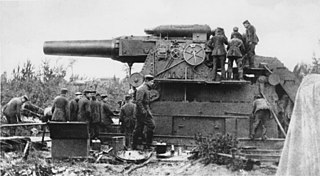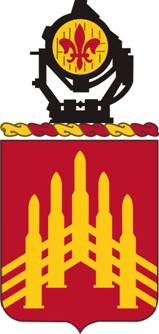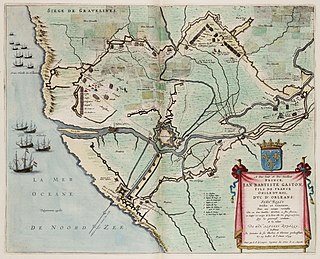
The Battle of Resaca de la Palma was one of the early engagements of the Mexican–American War, where the United States Army under General Zachary Taylor engaged the retreating forces of the Mexican Ejército del Norte under General Mariano Arista on May 9, 1846. The United States emerged victorious and forced the Mexicans out of Texas.

The 42-centimetre kurze Marinekanone 14 L/12, or Minenwerfer-Gerät (M-Gerät), popularly known by the nickname Big Bertha, was a German siege howitzer built by Krupp AG in Essen, Germany and fielded by the Imperial German Army from 1914 to 1918. The M-Gerät had a 42 cm (17 in) calibre barrel, making it one of the largest artillery pieces ever fielded.

The Royal Regiment of Canadian Artillery is the artillery personnel branch of the Canadian Army.

The Battle of Somosierra took place on 30 November 1808, during the Peninsular War, when a combined Franco-Spanish-Polish force under the direct command of Napoleon Bonaparte forced a passage through a Spanish Division stationed at the Sierra de Guadarrama, which shielded Madrid from direct French attack. At the Somosierra mountain pass, 60 miles (97 km) north of Madrid, a heavily outnumbered Spanish detachment of regulars, volunteers and artillery under Benito de San Juan aimed to block Napoleon's advance on the Spanish capital. Napoleon overwhelmed the Spanish positions in a combined arms attack, sending the Polish Chevau-légers of the Imperial Guard at the Spanish guns while French infantry advanced up the slopes. The victory removed the last obstacle barring the road to Madrid, which fell several days later.

Field artillery is a category of mobile artillery used to support armies in the field. These weapons are specialized for mobility, tactical proficiency, short range, long range, and extremely long range target engagement.

Horse artillery was a type of light, fast-moving, and fast-firing artillery which provided highly mobile fire support, especially to cavalry units. Horse artillery units existed in armies in Europe, the Americas, and Asia, from the early 17th to the mid-20th century. A precursor of modern self-propelled artillery, it consisted of light cannons or howitzers attached to light but sturdy two-wheeled carriages called caissons or limbers, with the individual crewmen riding on horses. This was in contrast to the rest of the field artillery, which were also horse-drawn but whose gunners were normally transported seated on the gun carriage, wagons or limbers.

The Battle of Honnecourt took place on 26 May 1642, during the 1635 to 1659 Franco-Spanish War. A Spanish army led by Francisco de Melo defeated and largely destroyed a French force under the Comte de Guiche.

Dom Francisco de Melo was a Portuguese nobleman who served as a Spanish general during the Thirty Years' War.
3rd Regiment Royal Horse Artillery is a regiment of the Royal Horse Artillery in the British Army. They are currently based at Albemarle Barracks, Northumberland, England.

The Battle of La Marfée, also known as the Battle of Sedan, took place on 6 July 1641, during the 1635 to 1659 Franco-Spanish War, a related conflict of the Thirty Years War.

The 42 cm kurze Marinekanone L/12, or Gamma-Gerät, was a German siege gun built by Krupp. The Gamma-Gerät's barrel diameter was 42 cm (17 in), making it one of the largest artillery pieces ever fielded. The Gamma-Gerät began development in 1906 and entered service with the Imperial German Army in 1911. The Gamma-Gerät was the most powerful piece of artillery fielded by the Imperial German Army, but due to its extreme weight was mostly immobile and could only be emplaced near permanent rail lines. As a result, the Gamma-Gerät had limited effectiveness on the Western and Eastern Fronts of World War I.
The 258th Field Artillery Regiment or "Washington Greys" is a field artillery unit of the New York Army National Guard that traces its lineage from 1809 to present. Circa 1957–1966 it consisted of four battalions.

The 5th Air Defense Artillery Regiment is an Air Defense Artillery regiment of the United States Army, first formed in 1861 in the Regular Army as the 5th Regiment of Artillery.

The 71st Air Defense Artillery was a regiment in the United States Army.
I Parachute Battery Royal Horse Artillery is the Headquarters battery of 7th Parachute Regiment Royal Horse Artillery, part of the Royal Horse Artillery of the British Army, currently based in Albemarle Barracks in Newcastle Upon Tyne.
The 50th Coast Artillery Regiment was a Coast Artillery Corps regiment in the Regular Army. It was mobilized in World War I and World War II.

The 1644 siege of Gravelines took place during the 1635 to 1659 Franco-Spanish War. A French army captured the port of Gravelines, then in the Spanish Netherlands, now the Pas-de-Calais region of northern France.

The M1841 12-pounder howitzer was a bronze smoothbore muzzle-loading artillery piece that was adopted by the United States Army in 1841 and employed during the Mexican–American War and the American Civil War. It fired a 8.9 lb (4.0 kg) shell up to a distance of 1,072 yd (980 m) at 5° elevation. It could also fire canister shot and spherical case shot. The howitzer proved effective when employed by light artillery units during the Mexican–American War. The howitzer was used throughout the American Civil War, but it was outclassed by the 12-pounder Napoleon which combined the functions of both field gun and howitzer. In the U.S. Army, the 12-pounder howitzers were replaced as soon as more modern weapons became available. Though none were manufactured after 1862, the weapon was not officially discarded by the U.S. Army until 1868. The Confederate States of America also manufactured and employed the howitzer during the American Civil War.

The siege of Rocroi was a battle of the Franco-Prussian War, it was held in January 4 to the 6th, 1871 at Rocroi which was a bastion of France located to the west of Sedan. After an artillery fire by the Prussian army, the officer commanding the French troops at Rocroi was forced to surrender the Division Militia under General Schuler and Sendan and Wilhelm von Woyna. With the success of the Siege of Rocroi, the military spectrum was obtained on their hands were hundreds of prisoners along with many stocks, costumes and contemporary heavyweight artillery of the French. During this siege, the town of Rocroi was heavily destroyed. The fall of Rocroi marked one of the German army's consecutive victories in the war.















